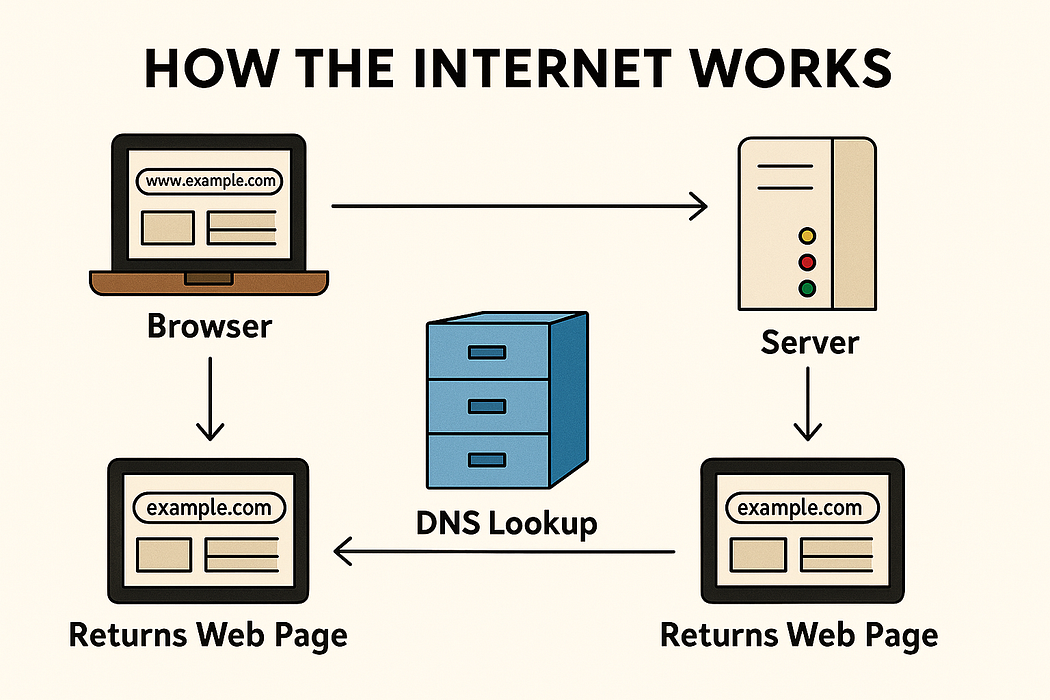🕸️ The Internet, Explained Like I’m Five — A Beginner’s Guide for Aspiring Developers
 Aditya Patra
Aditya Patra
“Have you ever wondered how clicking a link brings you a website in seconds?”
When I started learning web development, I quickly realized that before writing a single line of HTML, I needed to understand how the internet works.
In this article, I’ll explain it using the simplest language and analogies. Whether you’re an aspiring developer or just curious, let’s take a walk through the web together.
📦 What is the Internet?
Imagine the internet as a giant network of post offices.
Every house (your device) is connected to a local post office (your ISP), which knows how to route your letters (requests) to other post offices, and eventually to the right house (a server that has the website).
The internet is not a single place — it’s a collection of millions of devices (computers, phones, servers) that are all connected and can talk to each other.
🔄 How the Internet Works (Simple Version)
Let’s break it down:
1. ISP (Internet Service Provider)
This is your gateway to the internet. Think of it as your local post office that helps you send and receive packages.
Examples: Jio, Airtel, BSNL, etc.
2. DNS (Domain Name System)
When you type www.google.com, your computer doesn’t understand words—it understands IP addresses like 142.250.195.100.
So, your browser asks a DNS server:
“Hey, what’s the IP address of
google.com?”
And the DNS replies:
“Here it is:142.250.195.100.”
DNS = Phonebook of the internet.
3. IP Address
An IP address is like the street address of a computer on the internet. Just like your home has an address, every website and device does too.
4. Client-Server Model
Here’s where the real magic happens.
Client = Your browser (Chrome, Firefox)
Server = A powerful computer that stores websites
When you enter a URL and press enter:
The client sends a request to the server
The server finds the correct file (like
index.html)It sends the file back to your browser
You see the website
It’s like ordering food:
You (client) tell the waiter (API) what you want
The kitchen (server) prepares the dish
The waiter brings it back

🧠 Explained Simply
TermWhat It Really Means (In Simple Words)ClientThat’s you — or more precisely, your browser (like Chrome). It’s the one that asks for stuff from the internet.
ServerA powerful computer that stores websites and sends them to you when asked. Think of it like a restaurant kitchen that cooks up web pages.
BrowserThe app you use to surf the internet — like Chrome, Firefox, or Edge. It shows you web pages and lets you interact with them.
URLThe address of a website, like facebook.com or google.com. It’s what you type in the browser’s search bar to visit a site.
HTTP/HTTPSThe rules (protocols) your browser and the server follow to talk to each other. HTTPS is the secure version — like using a locked envelope to send data.
Request/ResponseThe back-and-forth exchange between your browser and the server. Your browser requests a page, and the server responds by sending it back.
Subscribe to my newsletter
Read articles from Aditya Patra directly inside your inbox. Subscribe to the newsletter, and don't miss out.
Written by

Aditya Patra
Aditya Patra
Final year CS student | Full stack developer | Open source contributor | Linux enthusiast | Learning DSA | Building innovative projects